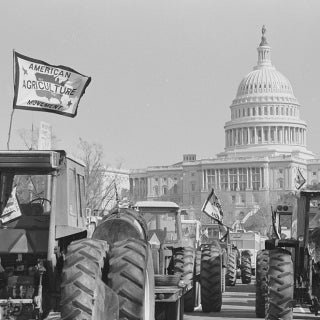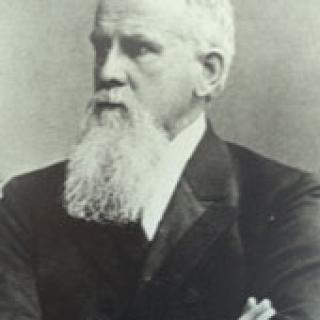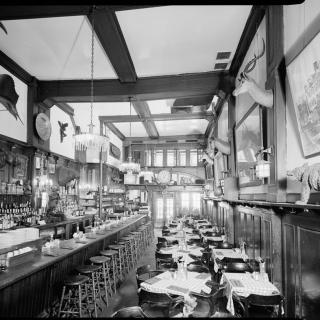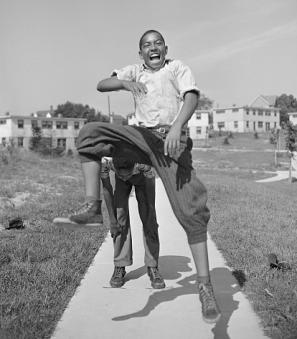The Silent Majority Storm The National Mall
Without doubt, the Vietnam War era was one of the most polarizing periods in modern American history.
Popular memory of the 1960s and 1970s evokes images of college students protesting on campuses across the country or singing protest songs on the National Mall. Some may remember Muhammad Ali's speech at Howard University or the Weather Underground's bombing of the Capitol.
But Richard Nixon’s election in 1968 was, in no small part, a response to that behavior and sentiment. Nixon drew a large portion of his support throughout the country, from a supposed “silent majority” of, Archie Bunker-like, blue collar, Americans who simply wanted things to stay the way they were.
Though anti-war demonstrations are more widely remembered, the March for Victory on April 4, 1970 marked the era’s largest pro-war demonstration, attracting about 50,000 protesters. The rally marked one instance when the “silent majority” got loud (but it wasn’t exactly pro-Nixon noise).[1]
When Nixon was elected to the presidency, in 1968, troop levels in Vietnam had ballooned from around 16,000 in 1963 to over 500,000. The “honorable end” Nixon’s campaign had promised included the war’s “Vietnamization” by reducing American forces and training South Vietnamese to maintain their own security and defense; planning on the complete withdrawal of American combat troops before 1973.
Many, including fundamentalist, radio-evangelist Reverend Carl McIntire, saw this continuous reduction of American forces as running away from our duty to fight against communism.[2]
“We’re going to demonstrate against the President’s policy of Vietnamization, which is a synonym for retreat,” McIntire proclaimed a few days before the march.[3]
“Millions of people voted for President Nixon, thinking he would seek victory in Vietnam, and now he’s backing out…We should give our generals the green light to win this war,” he added.[4]
The march, sponsored by McIntire’s International Council of Christian Churches, was to take place from Capitol Hill, down Pennsylvania Avenue, and end at the base of the Washington Monument.
Rather than the usual college-aged protesters, known for demonstrating against the war, the Victory March’s attendees were largely middle aged and elderly, featuring contingents of World War I, World War II, and Korean War veterans as well as Cuban exiles and members of the National Socialist White People’s Party, formerly the American Nazi Party, who according to The Washington Post did not join the actual march.[5]
The demonstrators carried signs and banners saying “Nixon is a No-Win Swine,” “In God we Trust,” and “Marxism is Jewish,” as well as Confederate and American flags and many wore “Wallace for President” hats. The few African-Americans proceeded awkwardly as “Dixie” was sung by the marchers, as an antagonism to the Civil Rights Movement’s use of the Battle Hymn of the Republic. While the war was a main point of contention, the masses demonstrated for and against a plethora of other issues including support for prayer in school, to stop bussing programs designed to desegregate schools, and just generally against “secular universities, and hippies and yippies everywhere.”[6]
The march was followed by speeches by a who’s who of Southern Democrats and critics of the New Left in America. Most of the speakers were as unhappy with the anti-war demonstrators as they were with the Nixon administration and what many felt to be poor decision making.
McIntire, at one point, introduced three Wisconsin Indians to raucous applause, who in support of the march said, “We ask that prayer and the Bible be put back in schools…and get rid of sex education in the lower grades…Scalp the Communists.”[7]
Democratic Congressman from Louisiana, John R. Rarick, railed against Nixon’s Vietnamization of the war as “programed [sic] defeat.” He proclaimed, “a people with the intelligence, the skills, the financial resources and the organizational ability to place astronauts on the Moon—not once but repeatedly—is surely capable of achieving military victory over a minor, backward, disorganized, fourth-rate dictatorsyip [sic]. We are here to take the first steps toward peace-through-Victory [sic]. The war in Vietnam is being fought and will be won or lost right here in Washington, D.C. The enemy has known this from the very first day, and he has conducted himself accordingly.”[8]
This kind of hawkish, anti-communist rhetoric was popular among the pro-war protesters, and its application was not exclusive to Southeast Asia. One attendee, Harold Davenport, a decorated World War II veteran from Shickshinny, Pennsylvania, carried a sign stating, “Give Jets to Israel.”[9]
“They need them,” Davenport said. “You take the Russians. They give the planes to the Arabs.”[10]
Georgia Governor, and staunch segregationist, Lester Maddox also spoke. By that time, in the early evening, the growing number of counter-protesters soon outnumbered the McIntire’s pro-war demonstrators, and the heckling of Maddox soon began.
Maddox’s speech focused largely on school integration, but echoed Rarick’s sentiment that the lack of public support for the war in Vietnam stemmed from a division at home, “[i]t is time for our nation to take off its mantle of sackcloth and assume the leadership the world expects. We did not lose our war over communism in Southeast Asia. We lost it in Washington.”[11]
Maddox continued, “Only by making it clear to our enemies both at home and abroad, that we are strong determined and fearless [sic] can we bring the shooting and the bombing to a halt.”[12]
The weeks following the March for Victory had a mixed bag of events, for everyone. Nixon really might not have had any plan of action. Within the month, Nixon announced both the withdrawal of an additional 150,000 troops from the warzone within the year and swiftly followed it up with the order to expand the war into Cambodia. In a weirder, more personal decision, the President made an impromptu early morning visit to the Lincoln Memorial and met with anti war protesters.
Though troop levels continued to drop and the war scaled down, it wasn’t until the Paris Peace Accords were signed in January 1973, that the administration’s end game for the war in Vietnam came into focus.
Footnotes
- ^ Stuart H. Loory, “Flags, Pro-War Signs Carried By Thousands in Capital Parade: Vietnam Victory Marchers Condemn School Prayer Ban, Bussing, the Supreme Court and U.S. Foreign Policy,” Los Angeles Times, April 5, 1970.
- ^ Gus Constantine, “Preacher Rallies For War,” Washington Evening Star, March 30, 1970.
- ^ Constantine, “Preacher.”
- ^ Stuart H. Loory, “Cleric Claims Sabotage of Victory Rally,” Los Angeles Times, April 1, 1970.
- ^ “Rally in D.C. Supports War Policy,” Boston Globe, April 5, 1970; Paul W. Valentine and Neil Maurer, “Big Rally Demands Victory: Thousands Protest Viet war Policy,” Washington Post, Times Herald, April 5, 1970.
- ^ Loory, “Flags;” Valentine and Maurer, “Big;” James Yuenger, “Thousands March in Washington to Seek U.S. Victory in Viet War,” Chicago Tribune, April 5, 1970.
- ^ Valentine and Maurer, “Big.”
- ^ Loory, “Flags;” “Rally in D.C.”
- ^ Loory, “Flags.”
- ^ Loory, “Flags.”
- ^ Yuenger, “Thousands;” Loory, “Flags.”
- ^ Valentine and Maurer, “Big.”





![Sketch of the mythical fuan by Pearson Scott Foresman. [Source: Wikipedia]](/sites/default/files/styles/crop_320x320/public/2023-10/Goatman_Wikipedia_Faun_2_%28PSF%29.png?h=64a074ff&itok=C9Qh-PE1)












